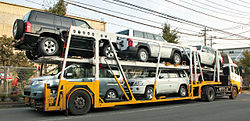The BMC-84 Freight Broker Bond is paid for on an annual basis. The freight broker bond cost is figured as a percentage of the bond amount depending on
Industry Reactions
The Association of Independent Property Brokers & Agents (AIPBA), a property broker trade group that claims 1,400 members, [11] has petitioned and lobbied against higher bond requirements when these have been proposed in the past, [12] and has harshly criticized the new law. The founder & president of AIPBA, James Lamb, has called the law a lobbyist-driven attempt to "eliminate small brokers from the market" and establish an oligopoly that charges customers more and pays carriers less. [13]
The National Association for Minority Truckers (NAfMT) [14] has also come out against the higher bond requirements. NAfMT CEO Kevin Reid called the $75,000 bond an "unreasonable barrier to entry for would-be entrepreneurs." He also spoke out against the new restrictions on owner-operators brokering out excess freight. The NAfMT has joined efforts by AIPBA to repeal the stricter surety requirements. [15]
Other industry associations have been supportive of the law. The Owner-Operator Independent Drivers Association (OOIDA), a group that represents independent trucking owner-operators, has been a key force behind the new regulations. While the final rules in MAP-21 fell short of the OOIDA's wishes, Todd Spencer, executive vice president of the organization, praised them as a "win-win" for truckers and legitimate brokers. [16]
The Transportation Intermediaries Association (TIA), [17] a major third-party logistics trade organization, has also advocated for the new FMCSA regulations through its lobbying arm TIAPAC as a way to protect motor carriers from both incompetent and unscrupulous brokers. TIA board member Ken Lund acknowledged that the new bond may be difficult for smaller brokers to pay, but defended it as "reasonably priced" and useful to prevent fraud. [18]
